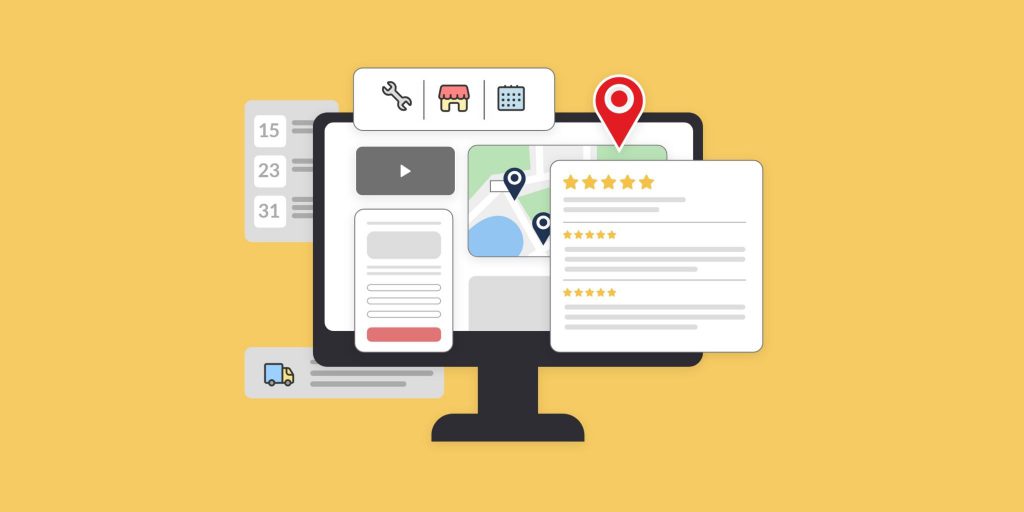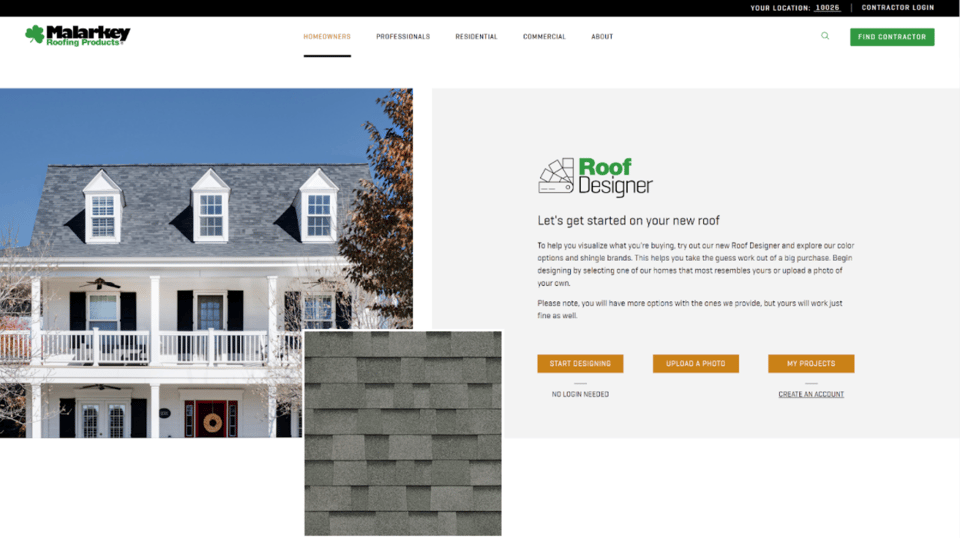Every business can benefit from good SEO practices. For companies of much larger size and scale, however, a marketer’s job can get more complicated.
To rank in search engines for both relevant local keyphrases and nationwide terms, large multi-location businesses — whether they’re building materials manufacturers, insurance companies, banks, or franchises — need a more sophisticated multi-location SEO strategy than single shops, or even small multi-location companies.
To illustrate this, consider the roofing manufacturer GAF. Their main website, GAF.com, should ideally rank in Google for the search term “solar roofing” nationwide, since that’s an important product category. GAF may also want to rank for keyphrases like “solar roofing in Raleigh, NC,” used by searchers in a given city.

SEO for a multi-location business might mean building out thousands of locally-optimized pages. Why is this important? According to Think with Google, “near me” type searches (such as “buy hardwood floors near me”) grew by 900% in recent years, and the trend is only continuing. Local searchers want to see personalized pages that describe the closest shop.
Data management can also be a hassle for larger firms. Updating hours, addresses, and more for thousands of branches or local dealers can be a huge drain on resources if done manually.
How should businesses with a wide regional footprint meet these challenges, and achieve better search rankings and online ROI at the same time? It’s possible, without huge time sinks or monetary costs. Here, we’ll share the best SEO options and strategies.
Multiple Domains vs. Subdomains vs. Subfolders: Which Is Best for Multi-Location SEO?
The terms multiple domains, subdomains, and subfolders refer to different website structure options. Each approach is reflected in the URLs of a company’s webpages, as follows:
- Multiple domains: www.example.com (and additional URLs, using words other than “example,” that are owned by the same company)
- Subdomains: subdomain1.example.com, subdomain2.example.com
- Subfolders: www.example.com/folder-1, www.example.com/folder-2
When it comes to local SEO for multiple locations, there are huge implications behind each option. An estimated 37,000 local searches happen every second. Your site structure affects how well you might be found by those searchers in Google and other search engines.
The choice you make between multiple domains, subdomains, and folders as a multi-location marketer can also affect the scalability of your SEO campaigns, as well as the ease of adding or updating local branch and retailer info.
Let’s break each approach down below, along with pros and cons:
Multiple Domains
Basically, multiple domains are entirely separate websites with different URLs.
A company with locations around the globe might use this approach for geotargeting and taking advantage of trusted ccTLDs (Country Code Top Level Domains), such as .co.uk for the United Kingdom and .fr for France. Multiple domains might also be used when a company spins out informational microsites, or wants to promote an entirely new corporate division or business model.
Pros: Multiple domains can increase opportunities for appearing in the SERPs (search engine results pages).
Cons: Different domains cannot inherit the search engine authority and “trust” earned over time by the original website. This means content creation and SEO efforts over time have to be restarted for each new domain. This increases costs, takes a long time, and gets harder for the business to manage as it expands into new locations or markets.
Subdomains
Subdomains, being attached to the main website domain, carry the sense of being more integrated into a company’s product offerings and main business model.
Subdomains are sometimes used when featuring product lines that are completely distinct from each other, and that speak to separate buyer personas. It is still not the most efficient approach, however.
Pros: Subdomains may take on some domain authority and trust from the main domain.
Cons: Whether or not subdomains inherit authority is debated among SEO specialists and hard to predict. This structure also increases resource drain and costs. The result? Local SEO for multiple locations is hampered, especially when many pages need to be built and updated.
Subfolders
Subfolders, also known as subdirectories, are the most popular approach. Subfolder usage is also increasingly recognized as the safest and most stable way to organize site info for SEO purposes.
Utilizing subfolders, both humans and search engines can “see” that company info is organized in a logical, hierarchical way. Using subfolders also lends scalability to data management. This works well both for diverse product lines and multiple locations.
This method is the easiest for maintaining a consistent design across all pages, leading to an enhanced user experience. Since 75% of a website’s credibility comes from design, this is key.
Pros: Subfolders fully inherit authority and trust from the main domain. They also are easier to work with in terms of link building, page updates, and multi-location SEO.
Cons: The biggest potential drawback is if a Google algorithm update punishes the entire website’s SEO strategy. That is unlikely, however, if you keep in step with local SEO best practices.
How Can Bullseye Location Software Help You Scale Your Large Multi-Location Business Strategy?
Bullseye is the answer when implementing local SEO for multiple locations. It’s the perfect cloud platform for a large company seeking to serve online prospects wherever they live.
Bullseye works best with a subfolder-based website structure, which as we’ve discussed, is the most adaptable approach for multi-location SEO. This structure allows Bullseye to provide local info when customers ask for it, and when search engines crawl for it.

Here are just a few ways Bullseye helps large businesses with an impressive footprint:
1. Create thousands of local pages with data imports
Bullseye instantly pulls data to dynamically create local optimized pages with your company’s branding on the fly, no matter how many hundreds or thousands are needed. Once Google users type in the phrase “near me” or similar, your Bullseye-generated local pages will bring high intent searchers to your website, where you can capture lead info for followup.
2. Manage your data better with Google My Business (GMB) & CRM integrations
Bullseye integrates seamlessly with your Google My Business account, helping to create a smooth user-experience for potential customers who are using Search, Maps, and other Google products.
Hand-in-hand with GMB, Bullseye synchronizes data across platforms and search tools and keeps NAP (name, address, and phone number) info consistent, which maintains SEO integrity and helps customers stay abreast of key location details. It also integrates with leading CRM tools like Salesforce, enabling you to nurture relationships with prospects who organically land on your site.
3. Keep customers happy with up-to-date store hours and other local info
Bullseye lets you update the regular, holiday, or temporary hours of multiple locations with ease. This gives customers planning to visit your shops or dealers confidence that you’ll be there as advertised. Adding a new location? It’s easy to generate new local pages with maps, social media links, and more custom info for each location in just a few clicks.
If you choose, you can also allocate this responsibility to your local partners themselves. There’s no need to worry about losing control over this process, thanks to Bullseye’s agile, secure user workflows: simply create one or more “area manager” roles to review any updates your partners make.
The benefits of this include:
- Updating your site with unique local content, which improves your site’s overall SEO.
- Saving time on updating and maintaining location data.
- Building rapport with partners by allowing them to change their own holiday hours, store descriptions, and other listing details.
Upgrade Your SEO Strategy With Bullseye
Bullseye’s benefits for large multi-location manufacturers, franchises, insurance companies and other businesses make the platform a game changer for multi-location SEO. Bullseye plus a subfolder structure equals less strain on resources, fewer marketing headaches, and more success being found by humans and search engines.
If you’re ready to get started with Bullseye, schedule an assessment of your current dealer locator page today.
Related Posts
How to Implement Successful Locator Onboarding

3 Types of Businesses that can Benefit from Local Pages







